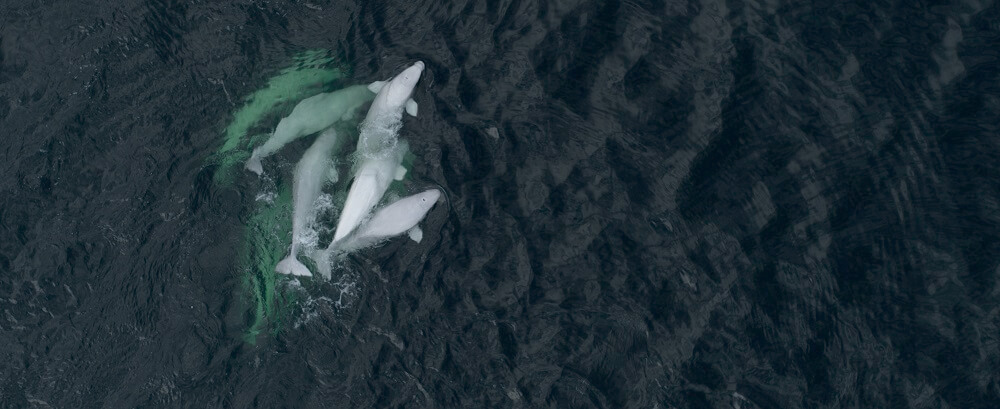Although drones are useful tools for conducting marine mammal research, it is legitimate to wonder what impact they may have on the individuals being studied. For the St. Lawrence beluga, which is closely monitored due to its endangered species status, drones are used to study behaviour, monitor pregnancies and assess the survival of calves and their state of health. A new study urges caution and recommends that clear benchmarks be established for using drones around belugas.
Head in the clouds, eyes on the water
During the summers of 2017 and 2018, Jaclyn Aubin and a team composed of members from GREMM and Ocean Wise carried out nearly 150 drone flights over belugas in Baie Sainte-Marguerite in the Saguenay Fjord. The 50 odd hours of footage collected was used to document, for the first time in the wild, care provided to young belugas by individuals other than their mothers.
As part of her PhD at Windsor University, Jaclyn and her colleagues used images captured between 2017 and 2018 to study the reaction of belugas to approaching drones and published their results on January 17. Their analyses made it possible to detect alert reactions in belugas in 30 of the 511 approaches made (5.9%) and avoidance reactions in 22 of these approaches (4.3%). These reactions only occurred when the flights took place at low altitude, i.e. when the drone was less than 23 metres high.
The researchers also observed that these reactions were more frequent in large pods of belugas, suggesting that these groups are either more cautious or more efficient in perceiving potential threats. However, they were unable to detect other impacts or identify other factors that might have influenced the animals’ reactions such as the drone’s speed or angle of approach, or wind or cloud cover at the time of the flight.
What about other cetaceans?
Other researchers have previously assessed the impact of drones on certain cetaceans and, although the studies vary in their conclusions, they do seem to share one common finding: it would appear that a drone flying at an altitude of less than 30 metres is more likely to cause disturbance. The bottlenose dolphin slaps its tail on the water surface and demonstrates alert behaviours in the presence of drones at low altitude (± 10 m). As with the beluga, this species also seems to exhibit more avoidance reactions when it is in large groups. In blue whales, a head-on drone approach causes the whale to dive prematurely.
When “studying” is synonymous with “protecting”
The research possibilities offered by drones are impressive and their use is becoming increasingly widespread. Knowing that drones, even when used in a very limited capacity, can be a source of disturbance for belugas, the researchers spearheading this study have made a few recommendations.
Firstly, drone operators are advised to operate their device at least 25 metres above the water surface and, secondly, to exercise caution when flying over large groups, as disturbance is more acute in such gatherings. Lastly, the researchers ask that drone operators pay attention to the speed of their equipment and its angle of approach and to exercise caution if there is little wind, as the impacts of these factors on cetaceans are not yet known!
Important reminder
The use of drones is prohibited within the boundaries of federal and provincial parks, notably the Saguenay-St. Lawrence Marine Park. Additionally, throughout the country, Fisheries and Oceans Canada’s Marine Mammal Regulations prohibit approaching marine mammals when flying at an altitude of less than 300 metres. The use of drones to study marine mammals is subject to a series of evaluations by ethics and animal welfare committees and requires a permit from Fisheries and Oceans Canada as well as park authorities if research activities are being carried out in these parks.






